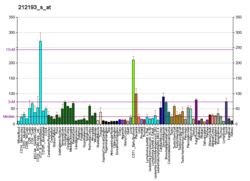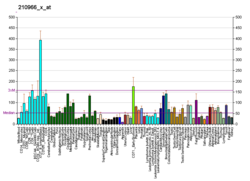
Protein disulfide-isomerase A3 (PDIA3), also known as glucose-regulated protein, 58-kD (GRP58), is an isomerase enzyme encoded by the autosomal gene PDIA3 in humans. This protein localizes to the endoplasmic reticulum (ER) and interacts with lectin chaperones calreticulin and calnexin (CNX) to modulate folding of newly synthesized glycoproteins. It is thought that complexes of lectins and this protein mediate protein folding by promoting formation of disulfide bonds in their glycoprotein substrates.

Structural maintenance of chromosomes protein 1A (SMC1A) is a protein that in humans is encoded by the SMC1A gene. SMC1A is a subunit of the cohesin complex which mediates sister chromatid cohesion, homologous recombination and DNA looping. In somatic cells, cohesin is formed of SMC1A, SMC3, RAD21 and either SA1 or SA2 whereas in meiosis, cohesin is formed of SMC3, SMC1B, REC8 and SA3.

Poly(rC)-binding protein 1 is a protein that in humans is encoded by the PCBP1 gene.

Non-POU domain-containing octamer-binding protein (NonO) is a protein that in humans is encoded by the NONO gene.

ELAV-like protein 1 or HuR is a protein that in humans is encoded by the ELAVL1 gene.

Insulin-like growth factor 2 mRNA-binding protein 1 is a protein that in humans is encoded by the IGF2BP1 gene.

Nucleolysin TIAR is a protein that in humans is encoded by the TIAL1 gene.

Probable ATP-dependent RNA helicase DDX20, also known as DEAD-box helicase 20 and gem-associated protein 3 (GEMIN3), is an enzyme that in humans is encoded by the DDX20 gene.

Double-stranded RNA-binding protein Staufen homolog 1 is a protein that in humans is encoded by the STAU1 gene.
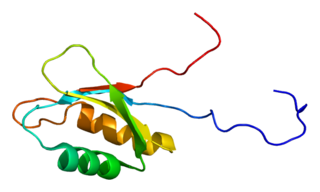
Insulin-like growth factor 2 mRNA-binding protein 3 is a protein that in humans is encoded by the IGF2BP3 gene.

Eukaryotic initiation factor 4A-I is a 46 kDa cytosolic protein that, in humans, is encoded by the EIF4A1 gene, which is located on chromosome 17. It is the most prevalent member of the eIF4A family of ATP-dependant RNA helicases, and plays a critical role in the initiation of cap-dependent eukaryotic protein translation as a component of the eIF4F translation initiation complex. eIF4A1 unwinds the secondary structure of RNA within the 5'-UTR of mRNA, a critical step necessary for the recruitment of the 43S preinitiation complex, and thus the translation of protein in eukaryotes. It was first characterized in 1982 by Grifo, et al., who purified it from rabbit reticulocyte lysate.

Zinc finger homeobox protein 3 is a protein that in humans is encoded by the ZFHX3 gene.

Chorion-specific transcription factor GCMa is a protein that, in humans, is encoded by the GCM1 gene.

THO complex subunit 1 is a protein that in humans is encoded by the THOC1 gene.

Fas-activated serine/threonine kinase is an enzyme that in humans is encoded by the FASTK gene.

Cytoplasmic dynein 1 intermediate chain 1 is a protein that in humans is encoded by the DYNC1I1 gene.
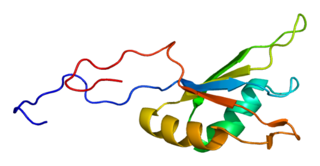
RNA binding motif protein 9 (RBM9), also known as Rbfox2, is a protein which in humans is encoded by the RBM9 gene.
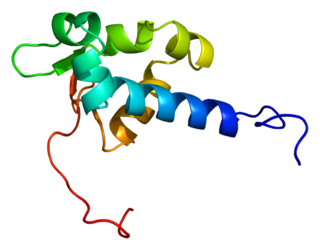
La-related protein 4 is a protein that in humans is encoded by the LARP4 gene. LARP4 is an RNA-binding protein which consists of a La motif (LaM), RNA recognition motif (RRM) and a putative PABP binding motif. It has been shown that LARP4 is involved in mRNA stability.

The Hippo signaling pathway, also known as the Salvador-Warts-Hippo (SWH) pathway, is a signaling pathway that controls organ size in animals through the regulation of cell proliferation and apoptosis. The pathway takes its name from one of its key signaling components—the protein kinase Hippo (Hpo). Mutations in this gene lead to tissue overgrowth, or a "hippopotamus"-like phenotype.

mTORC1, also known as mammalian target of rapamycin complex 1 or mechanistic target of rapamycin complex 1, is a protein complex that functions as a nutrient/energy/redox sensor and controls protein synthesis.




